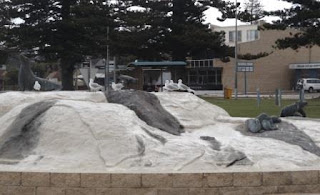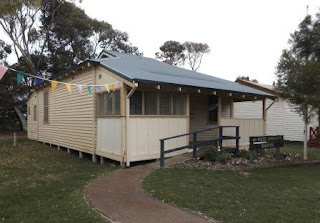Lovely
warm night. Overcast sky now. Still no TV reception so hooked up the van and
drove back to Esperance to watch the V8s. Back to our spot on the Esplanade –
don’t even have to put up the antenna here.
Great
qualifying and racing and it didn’t get too hot as there was a nice breeze
blowing in from the sea and the sky stayed cloudy all day (24 degrees).
Due
to the time difference the racing finished at 3pm so we went for a walk. Across
the road from us is Bow Park – named after the Bow family. The plaque is a bit
hard to read.
“Frederick
W Bow (1869-1959) and Emma Bow (1882-1926) were early settlers establishing
farming on the Esperance sand plain from 1911 onwards. They also leased three
islands, Woody, Charlie & Cull to graze sheep at the annual rent of one
pound each. They had 8 children, all raised and educated locally. Two of their
sons, A.J. (Moggie – born 1909) and C.L. (Charlie – born 1916), were well known
for their humour and generosity of spirit. They traded as ‘Bow Bros’ for many
years in a variety of businesses including farming, the butcher’s shop and a
fuel agency. Moggie’s auctions and ‘Bow Bros’ Butcher Shop were really
entertainment venues. Charlie was involved with Rotary, Tourist Bureau and the
Agricultural Society. Moggie was a life member of Esperance Football Club and
both were life members of Esperance Bay Turf Club. Both passed away January
1981.
In
the centre of the roundabout was bronze statues of seals, birds etc. The
seagulls love the water feature. One of my brochures had said to look out for
the seals entertaining people near the jetties.
The
Esplanade area is lovely with green grass and lots of playgrounds and picnic
areas – and the usual locals like we have at home!! The beach is a bit messy
with seagrass at the moment. Doesn’t look so inviting with the grey sky either.
The
toilets’ outside walls are pictures from the past. 1904 – loading camels at the
goods shed (now the museum). Some of the photos are from Len Daw, another early
settler family.
1896
– Ships ‘Lizzy Taylor’ and ‘Rob Roy’ loading Dempster’s wool on James Street
jetty.
1898
– Esperance townscape.
C1940
– Esperance Town Beach.
1904
– LtoR – The Esperance Hotel, the Grace Darling Hotel and the Pier Hotel.
The
Pier Hotel now – doesn’t look a patch on the old one.
On
the site of the old James Street jetty is a new sculpture – whale’s tail with
glass inserts.
The
old jetty has gone but I presume this groin is in its place.
Continued
along the Esplanade towards the old Tanker Jetty. The sea grass is a lot
thicker this side of the groin.
Across
the road are the blades from one of the first wind farms in WA at Salmon Beach.
Steve climbed up onto the lookout.
The
Esplanade keeps going but we turned off to check out the Museum Village.
The
Info Centre was closed and so were the shops in the village so we walked around
checking out all the old buildings that have been relocated here. First was the
Salmon Gums School (1928-1972) with the Matron’s House (1926) next door.
Sculptures
of pioneers etc are along the path.
Police
Sergeant’s Quarters (1927).
A.J.
Stewart – chemist (1896) and Doctor’s Surgery (1900).
A
plaque about the 1879 Telegraph Track – note the Station O.I.C was only 15
years old.
Railway
Station 1927.
Wow
– a pirate. He was a sealer operating from Middle Island with other sealers.
Remains of his huts are still evident on the island.
At
the Esperance Museum there were more plaques.
The
Skylab flew over Esperance. We read about it at Balladonia as we came across
the Nullarbor.
Rain
(well a nice shower) came down so we hid in the museum which was about to
close. Lots of mozzies as there is a lake beside the museum.
When
it stopped we walked across the road. First school (1896) – later used for
municipal council, roads board office. Now the RSL use it.
A
German Leopard tank.
Lovely
mural of the Light Horsemen.
The
museum is huge.
Great
sign.
Amazing
to read about this family walking from Albany to Israelite Bay in search of a
dream.
Some
history of Esperance – French explorers are credited with making the first
landing in Esperance, whilst sheltering from a storm in 1792 off Observatory
Point. The town itself was named after the French ship, L’Esperance, which is
French for ‘hope’. There are 110 islands in the Archipelago which was named
after the second ship, Recherche (meaning ‘research’). In 1802 British
navigator, Matthew Flinders, sailed through the Bay of Isles and named several key
Esperance locations, including Lucky Bay and Thistle Cove. The aboriginal name
for this area is “Kepa Kurl”, which means ‘the place where the waters lay down
like a boomerang’. In 1841 Edward John Eyre with his aboriginal guide Wylie,
met Captain Rossiter on their epic journey from Adelaide, aboard the French
Whaler ‘Mississippi’ in the bay which is now known as Rossiter Bya. Wylie Bay
was named by Eyre to honour his guide. The Esperance townsite was first settled
by the Dempster brothers in the 1860s, when they walked from Northam to
Esperance with their families, aboriginal guides and over 3000 head of stock.
When gold was discovered in Coolgardie in 1892, Esperance became a hub of
activity as miners came from far and wide and the town became the principal
port of the goldfields. The Esperance town was formally gazetted in 1893 and
farming and agriculture were the key industries. In 1908 Esperance suffered a
severe setback with the opening of the Perth to Coolgardie railway and was
reduced to a holiday resort and fishing town. However, the town attracted
enormous publicity in the early 1950s when American investors established large
landholdings east of Esperance. The success of their farming methods caused an
influx of new farmers from all parts of Australia. The town continued to
flourish as a farming community, and in 1962 work commenced on the Port
Authority, which saw the Esperance economy diversify. The port handled over 14
million tonnes of product involving 200 ships in 2015 including wheat, barley,
oats, lupins, peas and minerals (iron ore and nickel).
Back
to the van. Erica rang for a chat about her computer etc.
I
had put a stew in the Ecopot at lunchtime so dinner was all organised!!
Stars
came out in the late evening.



























































No comments:
Post a Comment